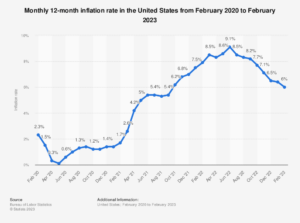Resources
U.S. Inflation Outlook 2023
By Shani Leead
Mar. 27, 2023
Summary
-
As of February 2023, the inflation rate is at 6%, which is a significant improvement from the previous two years following the pandemic.
-
Understanding how the Consumer Price Index (CPI) reflects the state of the economy can help you decide how to respond and support your employees. — More
-
Keeping an eye on interest rate hikes will aid you in forecasting inflation and, as a result, the effect on the job market. — More
-
Job growth has remained strong recently, yet there are still many unfilled jobs and a volatile work environment marked by layoffs and high turnover rates. — More
-
Wages and salaries are not keeping up with inflation, further contributing to the volatile job market. — More
-
The possibility of a recession remains uncertain as experts weigh in with opposing predictions. — More
Inflation, recession, interest rate hikes, GDP growth, stock market crashes… It seems no matter where you look these days, the media raises concerns surrounding these economic indicators. Considering the toll that the pandemic has had on the economy, it is no surprise that people want to know what we can expect from the economic landscape of 2023.
In general, the Federal Reserve aims for an annual inflation rate of around 2%. This is a slow, steady, and predictable level of inflation, which is a sign of a growing and healthy economy. But when the measure of inflation increases too far above that ideal number, as it has recently, we begin to see a ripple of negative effects.
Inflation can negatively impact the cost of living and the labor market and increase the likelihood of a recession. Staying informed on inflation statistics can help you prepare for the worst while looking out for the best interests of your employees and your business.
Current Consumer Price Index
The Consumer Price Index (CPI) is a methodology used by the US Bureau of Labor Statistics (BLS) to calculate the average change in prices over time. This change in the US economy is represented as a percent change, which is reported monthly. Keeping tabs on the changing CPI can give you insight into economic changes that may be impacting you and your employees.
As of February 2023, the inflation rate is at 6%. Though it is lower than the rates last year (a sign of improvement), it is still a high rate, which most people in the US and around the world have certainly felt the impact of.

If you take a look at the details of the current CPI data, you’ll see the weighted averages spent by all urban consumers for a market basket of goods and services.
The rising cost of living can affect how much your employees spend on healthcare, housing, food, and other essentials. For example, egg prices have risen 8.5%, which is 70.1% higher than a year ago. However, thankfully, inflation does not necessarily affect all avenues equally. Medical care services, airline fares, and used vehicle prices have gone down in recent months.
A CPI inflation calculator helps you evaluate price changes between months or year over year. This can help you make informed decisions about how to keep business costs low and operate as efficiently as possible.
To support your workers during these tough financial times, consider providing additional benefits to reduce cost burdens. These could include offering:
- Additional health benefits such as fertility treatment
- Payments toward student loan balances
- Daycare subsidies or daycare services at work
- Educational growth opportunities and certifications
- Weekly meal stipends or team lunches
Interest rate hikes and inflation forecasting
Paying attention to interest rate hikes and inflation forecasting is another way to prepare your business and workforce for what may unfold. Last year, price inflation rose to the highest level it had been in 41 years. Since March 2022, the central bank has increased its benchmark interest rate eight times. As a result, the inflation rate is poised to be trending down over the next year.
However, raising interest rates too high or too quickly can slow down the economy and impact the labor market. For example, raising interest rates can increase unemployment as higher interest rates may discourage business expansion and, thus, hiring.
Recently, higher interest rates have also made it costlier for consumers to take out loans for homes, cars, or other large retail sales. As a result, demand drops, and jobs become at risk of being cut while the fear (and unfortunate reality) of layoffs increases. This causes yet another cascade of consequences that further impact economic growth. For example, as consumers become more conservative in spending, sales and the amount of work to be done go down. As a result, turnover increases as workers fear layoffs and leave for more secure roles.
To avoid layoffs, it’s best to be conservative about hiring and slow down recruiting efforts during these precarious times. It is also important to stay organized and maintain transparency throughout your company. This might mean hosting more routine financial meetings or check-ins to keep everyone on the same page and allow leadership to make informed monetary decisions.
Job growth
According to a poll from Monster, 96% of workers reported the intention to look for a new job as of January 2023. In fact, one survey reports that 85% of those in the gig economy have increased or plan to increase their workload to combat inflation.
Luckily, as of February 2023, job growth has been strong. The unemployment rate is at 3.6%, which is relatively low. The labor force participation rate is at 62.5%, which is close to the number we had pre-pandemic. However, although more people have returned to the workforce, there are some companies, particularly in the services and healthcare sectors, that still struggle with a labor shortage.
Currently, there are nearly 11 million unfilled jobs across the nation. This may have two negative effects on your business. First, if you are one of those businesses with unfilled jobs, then those who currently work for you may be burnt out by the amount of extra work on their plates. Second, the fact that there are so many jobs available may cause your employees to leave if they are too stressed, overworked, or dissatisfied in their current roles.
It’s important to monitor your workforce and make sure everyone has a realistic workload. You should also create an action plan in the event that you do see an increase in employee turnover. For example, both in the face of inflation and based on your financial needs, is it best to replace, repurpose, or outsource the work done by those staff members?
Lastly, it’s vital to pay attention to how turnover affects employee morale, as it has a contagious effect. If you can take precautions to prevent turnover, or at least take care of and reward those who are still with you, you might be able to avoid a hiring crisis at work.
Wages & salaries
When prices rose due to inflation, average hourly earnings fell 1.3% from the previous year. In a report by Remote.co, 80% of respondents said that their salary was not keeping up with inflation. When everything is more expensive, and salaries either stay the same or decrease, the real-life consequences are brutal. Essentially, employees are doing the same work but can afford less. Unfortunately, on a global scale, lower-income earners have been the most impacted by these changes.
In some places around the world, monetary policies, such as minimum wage standards, have been used to combat this discrepancy. For example, in California, the minimum wage rate was increased to $15.50 per hour as of January 1, 2023. By working against the deterioration of real wages, states can help maintain economic growth and higher employment levels.
From an HR and leadership perspective, there are measures that you can implement to protect your staff’s wages and supplement their income. These include:
- Providing grocery vouchers or gift cards, especially to low-income households
- Offering bonuses and salary increases to keep your best talent and keep up with inflation
- Adjusting performance expectations and goals to reduce workload and reflect adequate work for fair pay
- Offering health and well-being benefits such as access to gym memberships, flexible work options, extra time off for vacation, and wellness programs
The possibility of recession
There are various theories for what exactly causes a recession. In some cases, it is caused by high inflation with too-high interest rates, while in others, it’s due to high inflation with too-low interest rates. The one thing we do know is that if we go into a recession, the labor market will likely suffer.
Depending on who you ask or where you are in the world, some economists will say the data points to a thriving economy in which we avoid a recession. Other economists point to slow growth as a signal of a high likelihood of a global recession.
David Mericle, Chief US Economist at Goldman Sachs, believes that we can avoid a recession. He states that “a continued period of below-potential growth can gradually rebalance supply and demand in the labor market and dampen wage and price pressures with a much more limited increase in the unemployment rate than historical relationships would suggest.”
Mericle also believes that we will continue to see a drop in the job-workers gap, which has fallen from 5.9 million to 4 million. However, Mericle and his team estimate that the gap needs to shrink to 2 million in order to be more sustainable with wage growth.
Another reason Mericle states that we may be able to avoid a recession is because of the overall decline in core inflation. He notes that although the supply chain recovery took a while, there seems to be a pattern of deflation in core goods.
Nobody can predict the future for certain. However, you can take steps to help protect the mental health and financial security of your workforce. For example, are your employees financially literate? Do they understand how to prepare for a potential recession?
Here are a few ideas to support your staff:
- Invest in leadership training, especially around mental health and supporting workers that are stressed about a potential recession or other financial issues.
- Offer educational courses or share resources on how to plan and manage their financial futures.
- Offer a flexible work-life balance, such as remote work, hybrid work, or four-day workweeks, to cut down on commute time/stress and expenses.
What the experts predicted
Late last year, Curtis Dubay, Chief Economist for the U.S Chamber of Commerce, provided some insight on the trajectory of the economy heading into 2023. According to Dubay, inflation expectations for 2023 “remained anchored” at the time due to pressure from higher interest rates. From what we have seen so far through March, these expectations have clearly been realized.
To hear more from Dubay’s talk, check out the free webinar below:
Webinar: 2023 Economic Outlook
The right tools to protect your workforce
While things are undoubtedly improving, businesses still need to remain hyper-focused on their labor costs. With inflation still relatively high, it’s important for operations managers to optimize where, when, and how labor is distributed.
For example, with Workforce.com’s scheduling and forecasting solutions, you can adjust your staffing levels based on predicted demand. If demand is low, you can easily scale back your scheduled labor, preventing costly, overstaffed scenarios. This is especially crucial during unpredictable financial times when saving money and increasing efficiency is a top priority.
To find out more, get in touch with our team today.
Schedule, engage, and pay your staff in one system with Workforce.com.
